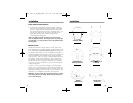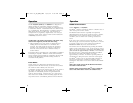
16
WARNING: Please read carefully and thoroughly.
• NFPA Standard 72 states: Life safety from fire in
residential occupancies is based primarily on early
notification to occupants of the need to escape,
followed by the appropriate egress actions by those
occupants. Fire warning systems for dwelling units are
capable of protecting about half of the occupants in
potentially fatal fires. Victims are often intimate with
the fire, too old or young, or physically or mentally
impaired such that they cannot escape even when
warned early enough that escape should be possible.
For these people, other strategies such as protection-in-
place or assisted escape or rescue are necessary.
• Smoke alarms are devices that can provide early
warning of possible fires at a reasonable cost; however,
alarms have sensing limitations. Ionization type alarms
offer a broad range of fire sensing capabilities but are
better at detecting fast flaming fires than slow
smoldering fires. Photoelectric alarms sense smoldering
fires better than flaming fires. Home fires develop in
different ways and are often unpredictable. Neither
type of alarm (photoelectric or ionization) is always
best, and a given alarm may not always provide
warning of a fire.
• A battery powered alarm must have a battery of the
specified type, in good condition and installed properly.
• AC powered alarms (without battery backup) will not
operate if the AC power has been cut off, such as by an
electrical fire or an open fuse.
• Smoke alarms must be tested regularly to make sure the
batteries and the alarm circuits are in good operating
condition.
• Smoke alarms cannot provide an alarm if smoke does
not reach the alarm. Therefore, smoke alarms may not
sense fires starting in chimneys, walls, on roofs, on the
other side of a closed door or on a different floor.
F i r e Safety F i r e Safety
15
• If the alarm is located outside the bedroom or on a
different floor, it may not wake up a sound sleeper.
• The use of alcohol or drugs may also impair one’s
ability to hear the smoke alarm. For maximum
protection, a smoke alarm should be installed in each
sleeping area on every level of a home.
• Although smoke alarms can help save lives by
providing an early warning of a fire, they are not a
substitute for an insurance policy. Home owners,
landlords and tenants should have adequate insurance
to protect their lives and property.
Good Safety Habits
Develop and practice a plan of escape!
• Install and maintain Fire extinguishers on every level of
the home and in the kitchen, basement and garage.
Know how to use a fire extinguisher prior to an
emergency.
• Make a floor plan indicating all doors and windows and
at least two (2) escape routes from each room. Second
story windows may need an escape ladder.
• Have a family meeting and discuss your escape plan,
showing everyone what to do in case of fire.
• Determine a place outside your home where you all
can meet if a fire occurs.
• Familiarize everyone with the sound of the smoke alarm
and train them to leave your home when they hear it.
• Practice a fire drill at least every six months, including
fire drills at night. Ensure that small children hear the
alarm and wake when it sounds. They must wake up in
order to execute the escape plan. Practice allows all
occupants to test your plan before an emergency. You
may not be able to reach your children. It is important
they know what to do.
0918-7227-02_DC_MAN_ENG 10/5/04 4:40 PM Page 14














